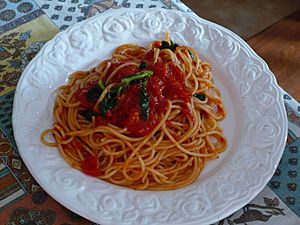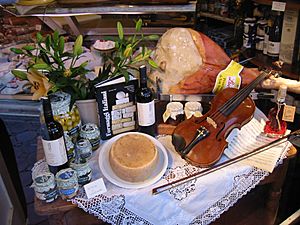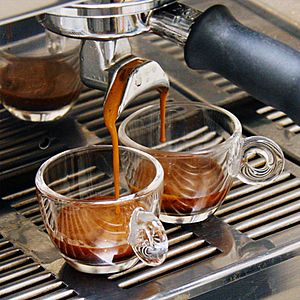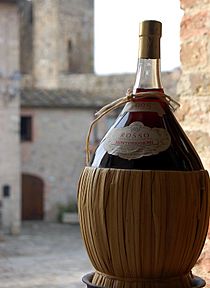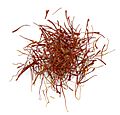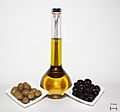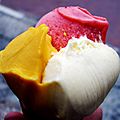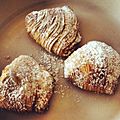Italian cuisine facts for kids
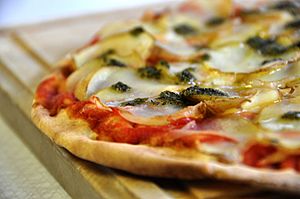
Italian cuisine is the delicious food that comes from Italy. It has grown and changed over hundreds of years, with its beginnings going all the way back to ancient times.
Big changes happened when the "New World" (the Americas) was discovered. New foods like potatoes, tomatoes, bell peppers, maize (corn), and sugar beet came to Italy. Italian food is famous for being different in each region, especially between the north and the south. It has many amazing tastes and is one of the most loved and copied cuisines worldwide. It has even influenced food in other countries, like the United States.
Italian cooking is usually simple. Many dishes have only two to four main ingredients. Italian chefs focus on using high-quality ingredients rather than complicated cooking methods. The ingredients and dishes change from one region to another. Many dishes that were once only found in one area are now popular all over Italy.
Pasta, vegetables, olive oil, and fish are a big part of Italian food. Italian cuisine is a great example of the healthy Mediterranean diet.
Contents
The History of Italian Food
Italian food has a long and interesting history. Even though Italy became one united country only in the 1800s, its food traditions go back to the 4th century BCE. Food and culture were very important back then. There was even a cookbook called "Apicius" from the 1st century BC!
Over time, many things influenced Italian food. These included neighboring areas, invaders, famous chefs, big political changes, and the discovery of the New World. Italian food really started to take its own shape after the fall of the Roman Empire. Different cities began to create their own unique food traditions. Many kinds of bread and pasta were made, and cooking styles varied.
Italy was divided into different food zones. For example, northern Italy (Milan) is known for its creamy risottos. Central Italy (Bologna) is famous for tortellini, which are small, filled pasta shapes. Southern Italy (Naples) is well-known for its delicious pizzas and spaghetti dishes.
What Ingredients Are Used?
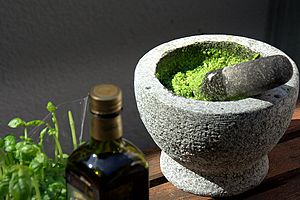
Italian cooking uses a wide variety of ingredients. These include fruits, vegetables, sauces, and meats. In northern Italy, common ingredients are fish (like cod), potatoes, rice, corn, sausages, pork, and many types of cheese. Pasta dishes with tomatoes are popular all over Italy. Italians like their ingredients fresh and seasoned simply.
In Northern Italy, you'll find many kinds of stuffed pasta. But polenta (a dish made from cornmeal) and risotto (creamy rice dishes) are also very popular. In the Liguria region, fish and seafood are common. Basil (used in pesto), nuts, and olive oil are also used a lot.
In Emilia-Romagna, you'll find ingredients like prosciutto (cured ham), different kinds of salami, and truffles. Famous cheeses like Grana and Parmigiano-Reggiano are from this area. Tomatoes are also key, used in sauces like ragù.

Traditional Central Italian food uses tomatoes, all kinds of meat, fish, and pecorino cheese. In Tuscany, pasta (especially pappardelle, which are wide noodles) is often served with meat sauces, including game meat.
In Southern Italy, fresh or cooked tomatoes are very important. Other key ingredients include peppers, olives, olive oil, garlic, artichokes, oranges, ricotta cheese, eggplants, zucchini, certain types of fish (like anchovies, sardines, and tuna), and capers.
Italian cuisine is also famous for its many different types of pasta. Pasta comes in various lengths, widths, and shapes. Some common shapes are penne, maccheroni, spaghetti, linguine, fusilli, and lasagne. There are also filled pastas like ravioli and tortellini.
The word "pasta" can also mean a dish where pasta is the main part. It's usually served with a sauce. There are hundreds of different pasta shapes, each with its own local name.
Examples include spaghetti (thin rods), rigatoni (tubes), fusilli (swirls), and lasagne (sheets). Dumplings like gnocchi (made with potatoes or pumpkin) and noodles like spätzle are sometimes considered types of pasta. Both are traditional in some parts of Italy.
How Meals Are Structured
Traditionally, Italian meals often have four or five courses. Especially on weekends, meals are a time to relax with family and friends. So, they tend to be longer than in other countries. During holidays like Christmas, feasts can last for many hours!
Today, the full traditional Italian menu is mostly for special events like weddings. For everyday meals, people usually have just the first course, or the second course, plus a side dish, and coffee. A special thing about Italian meals is that the primo (first course) is often a hearty dish like risotto or pasta. Italian food also has "all-in-one" dishes that combine carbohydrates and proteins, like pasta with beans.
| Part of the Meal | What it is |
|---|---|
| Aperitivo | A drink before the meal, like Prosecco or Spritz. It's like an appetizer drink. |
| Antipasto | Literally "before the meal." These are hot or cold appetizers, often cheese, ham, and bread. |
| Primo | "First course." This is usually a hot dish like pasta, risotto, gnocchi, or soup. |
| Secondo | "Second course." This is the main dish, usually fish or meat with potatoes. In the North, veal, pork, and chicken are common. Fish is very popular, especially in the South. |
| Contorno | "Side dish." This can be a salad or cooked vegetables. It's often served with the main course. |
| Formaggio e frutta | "Cheese and fruits." This is like a first dessert. Local cheeses might also be part of the antipasto or side dish. |
| Dolce | "Sweet." This is the main dessert, like cakes (such as Tiramisu), cookies, or ice cream. |
| Caffè | Coffee, usually a strong espresso. |
| Digestivo | "Digestives." These are drinks like grappa or limoncello that people have after coffee to help with digestion. |
Drinks in Italy
Coffee
Italian coffee (called caffè or espresso) is made from a special mix of coffee beans. The beans are roasted differently depending on the region.
Espresso is usually served in a small cup. Caffè macchiato has a little steamed milk or foam on top. Ristretto is made with less water, so it's even stronger. Cappuccino has steamed, frothy milk and is usually a morning drink. Caffelatte is equal parts espresso and steamed milk, often served in a big cup. Latte macchiato is warm milk with a bit of coffee. Caffè corretto is "corrected" with a few drops of an alcoholic drink like grappa.
The bicerin is a special Italian coffee from Turin. It's a mix of cappuccino and hot chocolate, with a little milk. It's quite thick and often topped with whipped cream and chocolate powder.
Wine
Italy makes the most wine in the world! It also exports and drinks the most wine. A lot of this wine is used for blending with wines from other countries. Italy has twenty different wine regions. Many vineyards are working to show that Italian wine is high quality, not just cheap "jug wine."
In Italy, wine is commonly drunk with meals, along with water. It's rare for meals to be served with other alcoholic drinks.
Holiday Foods
Every region in Italy has its own special holiday recipes. On St. Joseph's Day (March 19th), people in Sicily thank Saint Joseph for saving them from a famine (a time of not enough food) long ago. The fava bean helped people survive, so it's a traditional part of St. Joseph's Day celebrations. Other customs include wearing red clothes, eating Sicilian pastries called zeppole, and giving food to those in need.
On Easter Sunday, lamb is served all over Italy. A typical Easter breakfast in Umbria and Tuscany includes salami, boiled eggs, wine, and special Easter cakes and pizza. The common cake for Easter is the Colomba Pasquale (meaning "Easter dove"). It's shaped like a dove and topped with almonds and pearl sugar.
On Christmas Eve, many people have a "light dinner" without meat, called cena di magro. Popular Christmas cakes are panettone and pandoro.
Images for kids
-
Saffron has been used in Italy for centuries
-
Bartolomeo Scappi, personal chef to Pope Pius V
-
Apicius, De re coquinaria (On the Subject of Cooking), 1709 edition.
-
DOCG and DOC labels on two bottles of Italian wine
-
Prosciutto di San Daniele PDO, one of the most imitated Italian products in the world. The marketing phenomenon of imitation of Italian agri-food products that have nothing to do with Italian cuisine is known by the name of Italian Sounding.
-
Parmigiano-Reggiano cheese
-
Various types of pasta
-
Traditional pizza Margherita, whose ingredients, tomato (red), mozzarella (white) and basil (green), are inspired by the colours of the national flag of Italy.
-
Barrels of aceto balsamico aging
-
Orecchiette with cime di rapa sauce
-
Pasta con i peperoni cruschi, a traditional dish from Basilicata
-
'Nduja with bread, with a piece of 'Nduja sausage in background.
-
Mozzarella di bufala is a dairy product traditionally made from buffalo milk in southern Italy
-
Tagliatelle with ragù
-
Frico, a traditional dish in the Friuli-Venezia Giulia region
-
Focaccia with rosemary. Focaccia is widely associated with Ligurian cuisine
-
Spaghetti alla carbonara
-
Ossobuco served with risotto alla milanese
-
A dish of pizzoccheri
-
Traditional Piedmontese agnolotti
-
Polenta with bagna càuda
-
Traditional carasau bread
-
Pasta alla Norma is amongst Sicily's most historic and iconic dishes.
-
Traditional Speckknödel soup. The cuisine of South Tyrol combines culinary influences from Italy and the Mediterranean with a strong alpine regional and Austrian influence
-
Finocchiona, a classic Tuscan Salami
-
Fontina cheese from Valle d'Aosta
-
Polenta served with sopressa and mushrooms, a traditional peasant food of Veneto
-
A typical Italian breakfast (colazione), consisting of cappuccino and cornetto
-
A classic Italian aperitivo
-
Italian wine and salumi
-
A pizzeria in Rosebank, Gauteng, South Africa
-
Bustrengo, a traditional Christmas dish in the Republic of San Marino.
-
Milanesa a la napolitana with French fries, an Italian-inspired dish based on the original cotoletta dish from Milan, common in South America.
-
Uruguayan torta frita, which derives from Italian gnocco fritto
-
A Chicken parmigiana, based on a combination of the Italian parmigiana di melanzane with a cotoletta. It is widespread in North America and Australia
-
The garden at an osteria in Castello Roganzuolo, Veneto, Italy
-
A pizzeria in Naples, Italy circa 1910
-
An agriturismo in Montepulciano, Tuscany, Italy
-
Panettone is a traditional Christmas cake
-
Gelato is Italian ice cream
-
Panna Cotta with garnish
-
Tiramisu with cocoa powder garnish
-
Cannoli with pistachio, candied fruit, and chocolate chips
-
Cassata marzipan cake
-
Sfogliatelle with custard filling
-
Neapolitan version of rum baba
See also
 In Spanish: Gastronomía de Italia para niños
In Spanish: Gastronomía de Italia para niños


